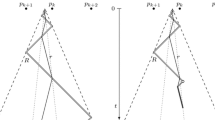Abstract
Consider a (robotic) explorer starting an exploration of an unknown terrain from its base station. As the explorer has only limited communication radius, it is necessary to maintain a line of robotic relay stations following the explorer, so that consecutive stations are within the communication radius of each other. This line has to start in the base station and to end at the explorer.
In the simple scenario considered here we assume an obstacle-free terrain, so that the shortest connection (the one which needs the smallest number of relay stations) is a straight line. We consider an explorer who goes an arbitrary, typically winding way, and define a very simple, intuitive, fully local, distributed strategy for the relay stations — our Go-To-The-Middle strategy — to maintain a line from the base station to the robot as short as possible.
Besides the definition of this strategy, we present an analysis of its performance under different assumptions. For the static case we prove a bound on the convergence speed, for the dynamic case we present experimental evaluations that show the quality of our strategy under different types of routes the explorer could use.
Partially supported by the EU within the 6th Framework Programme under contract 001907 (DELIS) and by the DFG-Sonderforschungsbereich SPP 1183: “Organic Computing. Smart Teams: Local, Distributed Strategies for Self-Organizing Robotic Exploration Teams”.
Chapter PDF
Similar content being viewed by others
References
Y. U. Cao, A. S. Fukunaga, and A. B. Kahng. Cooperative mobile robotics: Antecedents and directions. In Autonomous Robots, volume 4, pages 1–23, 1997.
C. W. Reynolds. Flocks, herds, and schools: A distributed behavioral model. In Computer Graphics, pages 25–34, 1987.
Y. Liu and K. M. Passino. Swarm intelligence: Literature overview.
R. Arkin. Behavior-based robotics. Cambridge, MA: MIT Press, 1998.
G. Dudek, M. Jenkin, E. Milios, and D. Wilkes. A taxonomy for swarm robotics. In IEEE/TSJ International Conference on Intelligent Robots and Systems, pages 441–447, 1993.
K. Sugihara and I. Suzuki. Distributed motion coordination of multiple mobile robots. In 5th IEEE International Symposium on Intelligent Control, volume 1, pages 138–143, 1990.
Ichiro Suzuki and Masafumi Yamashita. Distributed anonymous mobile robots: Formation of geometric patterns. SIAM J. Computi., 28(4):1347–1363, 1999.
I. Chatzigiannakis, M. Markou, and S. Nikoletseas. Distributed circle formation for anonymous oblivious robots. In LNCS, volume 3059, pages 159–174, 2004.
Q. Chen and J. Y. S. Luh. Coordination and control of a group of small mobile robots. In IEEE International Conference on Robotics and Automation, volume 3, pages 2315–2320, 1994.
H. Ando, Y. Oasa, I. Suzuki, and M. Yamashita. Distributed memoryless point convergence algorithm for mobile robots with limited visibility. In IEEE Transactions on Robotics and Automation, volume 15, 1999.
Author information
Authors and Affiliations
Editor information
Editors and Affiliations
Rights and permissions
Copyright information
© 2006 International Federation for Information Processing
About this paper
Cite this paper
Dynia, M., Kutyłowski, J., Lorek, P., auf der Heide, F.M. (2006). Maintaining Communication Between an Explorer and a Base Station. In: Pan, Y., Rammig, F.J., Schmeck, H., Solar, M. (eds) Biologically Inspired Cooperative Computing. BICC 2006. IFIP International Federation for Information Processing, vol 216. Springer, Boston, MA . https://doi.org/10.1007/978-0-387-34733-2_14
Download citation
DOI: https://doi.org/10.1007/978-0-387-34733-2_14
Publisher Name: Springer, Boston, MA
Print ISBN: 978-0-387-34632-8
Online ISBN: 978-0-387-34733-2
eBook Packages: Computer ScienceComputer Science (R0)




